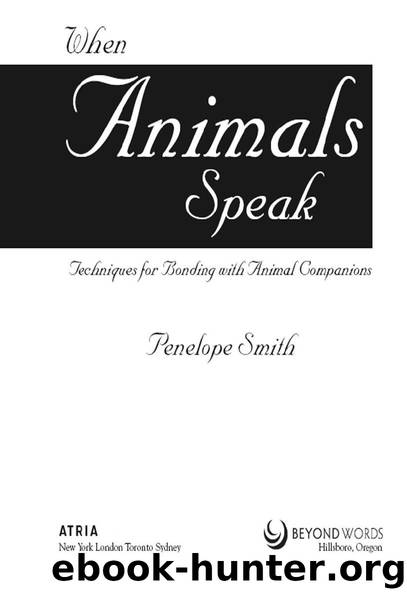When Animals Speak by Penelope Smith

Author:Penelope Smith
Language: eng
Format: epub
Publisher: Simon and Schuster
Published: 2009-07-15T00:00:00+00:00
A woman called me with concerns about the pigeons being killed by cars in a heavily trafficked area of a city. She had tried to communicate to them about the danger, but they continued to return to the street despite her warnings, and didn’t seem to listen to her or understand.
Tuning in to the pigeons, I felt their lack of concern over the traffic danger. They had their own world; they were accustomed to surviving independently of human direction and had no need to listen to the woman. Their flock was a group of beings who worked together, and they each seemed to survive as a member of the flock, even if their bodies were killed on the street. The idea of being “saved” was totally foreign to them. In order to communicate well with them, Margie would have to assume their viewpoint; by attaining harmony with their lives, her communication would be appropriate.
Nature has carefully engineered the predator–prey cycle. Animals (as spirit) generally leave their bodies as soon as a predator pounces. Even though the body keeps functioning and may struggle to get away, the spirit will often not return and take over conscious control unless the predator has gone away for a while. The body may be in a state of shock, with a dazed or faraway look, until the spirit decides it’s okay to rejoin it. When I have interfered with my cats’ hunting escapades and rescued chipmunks, rabbits, mice, or birds, the little animals need some coaxing to return to their bodies, even though uninjured physically. Nature also takes care of prey animals by triggering a release of endorphins into the body as the predator attacks, so no pain is felt after the initial blow.
Yohinta, our tortoiseshell cat, was a skillful huntress. We had a rule in our household that the cats must kill and eat their prey animals outside, not in the house. My office windows faced the pathway that Yohinta regularly took when she was bringing critters back into the yard. Sometimes I became involved in the life-and-death struggle.
I have tried to rescue chipmunks and release them before Yohinta or the other cats kill them. Often, despite my good intentions, they would run away from me, their rescuer, and scurry back under the nose or legs of the cat, expecting—almost asking—to be killed. It appears that a smaller cat predator that you know is preferable to a giant human predator that you don’t know! The predator–prey ritual is programmed into the species and agreed upon as part of natural living for those involved. Human rescuers may seem like an anomaly in the natural process.
Instead of interfering physically when Yohinta paraded past my window with a chipmunk in her mouth, I have found that working telepathically eliminated a messy struggle and was much more effective.
Cats often drop and pounce on an animal a number of times after they’ve made their catch. Chipmunks are usually in shock after a cat attacks, and don’t try to run away when the cat releases them.
Download
This site does not store any files on its server. We only index and link to content provided by other sites. Please contact the content providers to delete copyright contents if any and email us, we'll remove relevant links or contents immediately.
| ESP | Near-Death Experiences |
| Out-of-Body Experiences |
Animal Frequency by Melissa Alvarez(4426)
Sigil Witchery by Laura Tempest Zakroff(4207)
Real Magic by Dean Radin PhD(4100)
Fingerprints of the Gods by Graham Hancock(3964)
Aleister Crowley: The Biography by Tobias Churton(3605)
Journeys Out of the Body by Robert Monroe(3590)
The Rosicrucians by Christopher McIntosh(3491)
Alchemy and Alchemists by C. J. S. Thompson(3481)
Mysteries by Colin Wilson(3420)
Hitler's Monsters by Eric Kurlander(3291)
The Hatha Yoga Pradipika (Translated) by Svatmarama(3281)
Wicca: a guide for the solitary practitioner by Scott Cunningham(3149)
John Dee and the Empire of Angels by Jason Louv(3146)
Infinite Energy Technologies by Finley Eversole(2952)
Book of Life by Deborah Harkness(2893)
Dark Star Rising by Gary Lachman(2843)
The Book of Lies by Aleister Crowley(2817)
Aliens by Jim Al-Khalili(2803)
To Light a Sacred Flame by Silver RavenWolf(2787)
